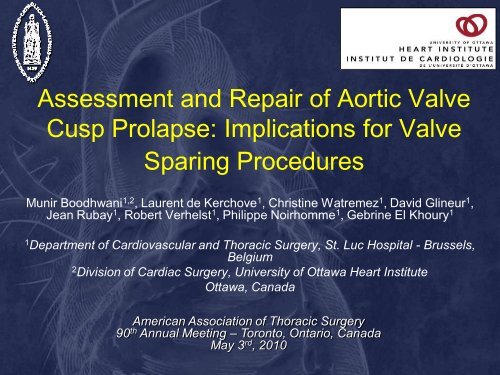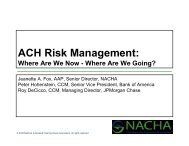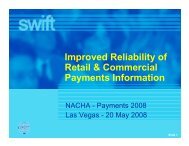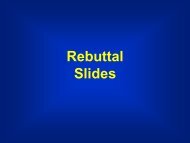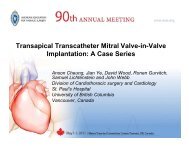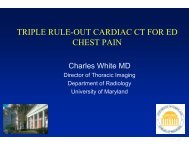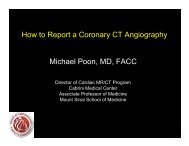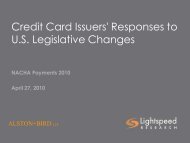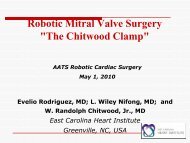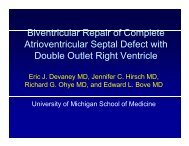Assessment and Repair of Aortic Valve Cusp Prolapse: Implications ...
Assessment and Repair of Aortic Valve Cusp Prolapse: Implications ...
Assessment and Repair of Aortic Valve Cusp Prolapse: Implications ...
Create successful ePaper yourself
Turn your PDF publications into a flip-book with our unique Google optimized e-Paper software.
<strong>Assessment</strong> <strong>and</strong> <strong>Repair</strong> <strong>of</strong> <strong>Aortic</strong> <strong>Valve</strong><br />
<strong>Cusp</strong> <strong>Prolapse</strong>: <strong>Implications</strong> for <strong>Valve</strong><br />
Sparing Procedures<br />
Munir Boodhwani 1,2 , Laurent de Kerchove 1 , Christine Watremez 1 , David Glineur 1 ,<br />
Jean Rubay 1 , Robert Verhelst 1 , Philippe Noirhomme 1 , Gebrine El Khoury 1<br />
1<br />
Department <strong>of</strong> Cardiovascular <strong>and</strong> Thoracic Surgery, St. Luc Hospital - Brussels,<br />
Belgium<br />
2<br />
Division <strong>of</strong> Cardiac Surgery, University <strong>of</strong> Ottawa Heart Institute<br />
Ottawa, Canada<br />
American Association <strong>of</strong> Thoracic Surgery<br />
90 th Annual Meeting – Toronto, Ontario, Canada<br />
May 3 rd , 2010
The authors have no conflicts <strong>of</strong> interest to<br />
disclose
<strong>Aortic</strong> <strong>Cusp</strong> <strong>Prolapse</strong><br />
• <strong>Cusp</strong> prolapse in trileaflet aortic valves is an<br />
infrequent cause for isolated aortic insufficiency<br />
– Shapiro et al. found an prevalence <strong>of</strong> 1.2% in a crosssectional<br />
review <strong>of</strong> 2000 echocardiograms<br />
• Most patients with isolated cusp prolapse<br />
currently undergo aortic valve replacement:<br />
– Unfamiliarity with diagnosis <strong>and</strong> assessment<br />
– <strong>Repair</strong> techniques<br />
– Lack <strong>of</strong> long-term outcome data
AV Sparing Surgery<br />
• Lack <strong>of</strong> recognition <strong>and</strong> treatment <strong>of</strong> cusp<br />
prolapse is an important reason for early <strong>and</strong><br />
late failure <strong>of</strong> valve sparing operations<br />
• <strong>Cusp</strong> prolapse may be pre-existing, unmasked,<br />
or induced during AV sparing surgery<br />
• Questions:<br />
– Will there be a need for cusp prolapse repair?<br />
– Which cusp(s) will need repair?<br />
– How much correction will be required?
Aims<br />
• To examine clinical, echocardiographic, <strong>and</strong> intraoperative<br />
characteristics <strong>of</strong> patients with isolated cusp prolapse <strong>and</strong><br />
with associated ascending aortic disease<br />
• To compare outcomes following aortic valve repair for<br />
cusp prolapse
Patient Population<br />
Patients undergoing<br />
AV <strong>Repair</strong><br />
(n = 428)<br />
Trileaflet AV<br />
(n = 111)<br />
excluded<br />
excluded<br />
No <strong>Cusp</strong> <strong>Prolapse</strong> <strong>Repair</strong><br />
(n = 234)<br />
Methods:<br />
• Review <strong>of</strong> prospectively collected surgical data<br />
<strong>Cusp</strong> <strong>Prolapse</strong> <strong>Repair</strong><br />
• Blinded review <strong>of</strong> preoperative Echocardiograms in all patients<br />
(n = 194)<br />
• Clinical <strong>and</strong> Echocardiographic follow-up<br />
Non-trileaflet AV<br />
(n = 83)<br />
– 100% complete<br />
– Mean follow-up: 3.8 years [range – 0.1 – 13.3 years]<br />
Isolated Group<br />
(n = 50)<br />
Associated Group<br />
(n = 61)
<strong>Aortic</strong> <strong>Cusp</strong> <strong>Prolapse</strong> - Diagnosis<br />
• Echocardiography<br />
– Different levels <strong>of</strong> cusp free margin<br />
– Low coaptation height<br />
– Eccentric AI Jet (not perpendicular<br />
to LVOT)<br />
– Excess cusp tissue (SAX view)<br />
– Fibrous b<strong>and</strong> on prolapsing cusp
Fibrous B<strong>and</strong>
Pathophysiology <strong>of</strong> <strong>Cusp</strong> <strong>Prolapse</strong><br />
• <strong>Cusp</strong> prolapse is associated with excess cusp motion<br />
<strong>Cusp</strong> Motion = Free Margin Length (FML)<br />
Insertion Length (IL)
<strong>Repair</strong> Techniques<br />
Free Margin Plication<br />
• Quick<br />
• Efficient<br />
• Minimal Foreign<br />
material<br />
Isolated: 37%<br />
Associated: 48%<br />
Boodhwani M, El Khoury G JTCVS 2010;139(4):1075-7.
<strong>Repair</strong> Techniques<br />
Free Margin Resuspension<br />
• Fragile Free Margin<br />
• Close Fenestrations<br />
• Homogenize free margin<br />
Isolated: 33%<br />
Associated: 32%<br />
Plication + Resuspension<br />
Isolated: 22%<br />
Associated: 17%<br />
Boodhwani, El Khoury G Op Tech Thoracic Cardiovasc Surg 2010 .
Technical Adjuncts<br />
• Two cusp prolapse<br />
– Non-prolapsing cusp serves as reference<br />
• Three cusp prolapse<br />
– Rare<br />
– Seen with AV sparing surgery<br />
– Restore coaptation height to mid-level <strong>of</strong> sinuses <strong>of</strong><br />
Valsalva
Clinical Characteristics<br />
Characteristic<br />
Isolated<br />
(n=50)<br />
Associated<br />
(n=61)<br />
p-value<br />
Age 57 16 56 17 0.68<br />
Male 46 (92%) 57 (92%) 0.97<br />
NYHA Class<br />
I<br />
II<br />
III<br />
13 (26%)<br />
27 (54%)<br />
10 (20%)<br />
31 (51%)<br />
26 (43%)<br />
4 (7%)<br />
0.01<br />
LV Ejection Fraction < 50% 12 (24%) 4 (7%) 0.008<br />
Previous Cardiac Surgery 6 (12%) 8 (13%) 0.86<br />
LVEDD (mm) 62 9 59 8 0.05<br />
<strong>Aortic</strong> Size (mm) - 51 7 -<br />
Concomitant Procedures<br />
CABG<br />
Mitral valve repair/replacement<br />
Other<br />
23 (46%)<br />
11 (22%)<br />
12 (24%)<br />
6 (12%)<br />
15 (25%)<br />
8 (13%)<br />
6 (10%)<br />
2 (3%)<br />
0.02
Echocardiographic Features<br />
AI Severity<br />
1+<br />
2+<br />
3+ or 4+<br />
Characteristic<br />
Isolated<br />
(n=50)<br />
0<br />
10 (20%)<br />
40 (80%)<br />
Associated<br />
(n=61)<br />
10 (16%)<br />
16 (26%)<br />
35 (57%)<br />
p-value<br />
0.005<br />
Eccentric Jet 40 (83%) 34 (63%) 0.02<br />
Fibrous B<strong>and</strong> 32 (67%) 20 (34%) 0.001<br />
<strong>Cusp</strong> <strong>Prolapse</strong> 41 (85%) 38 (66%) 0.02
Echocardiographic Features<br />
Characteristic Sensitivity Specificity<br />
Eccentric Jet 92% 96%<br />
Fibrous B<strong>and</strong> 57% 92%<br />
Fibrous b<strong>and</strong> correctly identified the prolapsing cusp in all cases
Intraoperative Data<br />
Characteristic<br />
Isolated<br />
(n=50)<br />
Associated<br />
(n=61)<br />
p-value<br />
Number <strong>of</strong> cusps repaired<br />
One cusp<br />
Two cusp<br />
Three cusp<br />
36 (72%)<br />
13 (26%)<br />
1 (2%)<br />
47 (77%)<br />
10 (16%)<br />
4 (7%)<br />
0.27<br />
<strong>Cusp</strong>s <strong>Repair</strong>ed<br />
Right Coronary <strong>Cusp</strong><br />
Non Coronary <strong>Cusp</strong><br />
Left Coronary <strong>Cusp</strong><br />
35 (70%)<br />
21 (42%)<br />
9 (18%)<br />
40 (66%)<br />
17 (28%)<br />
22 (36%)<br />
0.62<br />
0.12<br />
0.03<br />
<strong>Aortic</strong> Annulus Interventions<br />
Sub-Commissural Annuloplasty<br />
<strong>Valve</strong>-sparing root replacement<br />
Reimplantation Technique<br />
Remodelling Technique<br />
Supra Coronary <strong>Aortic</strong> replacement<br />
46 (92%)<br />
-<br />
-<br />
-<br />
13 (21%)<br />
49 (80%)<br />
2 (3%)<br />
11 (18%)<br />
-
Early Outomes<br />
• No hospital mortality<br />
• No early AV reintervention<br />
• Permanent Pacemaker – 3.6%<br />
• Post-repair Echo<br />
– AI grade 0 or 1+ : 95%<br />
– AI grade 2+ : 5%
Percent survival<br />
Overall Survival<br />
100<br />
80<br />
60<br />
40<br />
20<br />
Isolated<br />
Associated<br />
8 years<br />
88 12%<br />
82 9%<br />
0<br />
0 2 4 6 8 10<br />
No. at risk<br />
Years<br />
Isolated 50 43 30 18 11 7<br />
Associated 61 56 35 17 7 4
%<br />
Freedom from Cardiac Death<br />
100<br />
80<br />
60<br />
40<br />
Isolated<br />
Associated<br />
8 years<br />
88 12%<br />
97 3%<br />
20<br />
0<br />
0 2 4 6 8 10<br />
No. at risk<br />
Years<br />
Isolated 50 43 30 18 11 7<br />
Associated 61 56 35 17 7 4
%<br />
Freedom from AV Reoperation<br />
100<br />
80<br />
60<br />
40<br />
Isolated<br />
Associated<br />
8 years<br />
100%<br />
93 4%<br />
20<br />
0<br />
0 2 4 6 8 10<br />
No. at risk<br />
Years<br />
Isolated 50 43 30 18 11 7<br />
Associated 61 56 35 17 7 4
%<br />
Freedom from Recurrent AI > 2+<br />
100<br />
80<br />
60<br />
8 years<br />
40<br />
20<br />
Isolated<br />
Associated<br />
87 7%<br />
93 5%<br />
0<br />
0 2 4 6 8<br />
No. at risk<br />
Years<br />
Isolated 50 30 18 9 6<br />
Associated 61 40 22 7 5
%<br />
Freedom from Thromboembolism, Bleeding,<br />
<strong>and</strong> Endocarditis<br />
100<br />
80<br />
60<br />
8 years<br />
40<br />
98 2%<br />
20<br />
0<br />
0 2 4 6 8 10<br />
Years<br />
No. at risk 111 78 49 23 9 3
Subgroup Analysis<br />
• Number <strong>of</strong> cusps repaired (single vs. multiple)<br />
did not affect AV reoperation or AI recurrence<br />
(p = 0.25)<br />
• Choice <strong>of</strong> surgical technique (Plication vs.<br />
Resuspension vs. Both) did not affect repair<br />
durability (p = 0.6)
Conclusions<br />
• Isolated cusp prolapse causing AI is a distinct<br />
clinical entity with unique echocardiographic <strong>and</strong><br />
intraoperative features<br />
• <strong>Cusp</strong> prolapse is repairable with or without<br />
ascending aortic disease <strong>and</strong> leads to durable<br />
outcome <strong>and</strong> low risk <strong>of</strong> valve related<br />
complications (0.47%/person-yr)
<strong>Implications</strong> for AV Sparing Surgery<br />
• Eccentric AI jet is highly sensitive <strong>and</strong> specific for the<br />
diagnosis <strong>of</strong> pre-existing cusp prolapse <strong>and</strong> predicts the<br />
need for repair in the majority (63%) <strong>of</strong> patients<br />
• A fibrous b<strong>and</strong> is specific (92%) for cusp prolapse <strong>and</strong><br />
can help to localize the prolapsing cusp<br />
• Intraoperative assessment is critical for the diagnosis <strong>of</strong><br />
unmasked or induced cusp prolapse.
Thank You
Discussion Slides
%<br />
AV Sparing alone vs Sparing +AV repair<br />
Freedom from AI >2+<br />
100<br />
80<br />
60<br />
logrank test:<br />
p=0.8<br />
40<br />
20<br />
Sparing alone<br />
Sparing +AV repair<br />
0<br />
0 24 48 72 96 120<br />
Months<br />
patients at risk :<br />
Sparing 74 45 35 25 17 9<br />
Sparing+<strong>Repair</strong> 90 51 21 7 5 3
Predictors <strong>of</strong> Recurrent AI<br />
• Restoration <strong>of</strong> valve geometry is critical<br />
– Length <strong>and</strong> height <strong>of</strong> coaptation
Intraoperative Data<br />
Characteristic<br />
Isolated<br />
(n=50)<br />
Associated<br />
(n=61)<br />
p-value<br />
Cardiac Ischemia Time (min) 72 33 113 31
STJ – Sino-tubular Junction; SCA – Sub-Commissural Annuloplasty Boodhwani et al., JTCVS 2009;137:286-94


